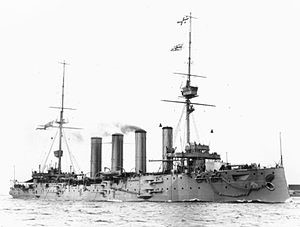Other Information
HMS Good Hope was sunk with all hands at the battle of Coronel. She was a Drake Class armoured cruiser. When war was declared in August 1914, the ship was ordered to reinforce the 4th Cruiser Squadron and became the flagship of Rear Admiral Christopher Cradock. Cradock moved the available ships of his squadron later that month to the coast of South America to search for German commerce raiders. He was then ordered further south to the Strait of Magellan to block any attempt of the German East Asia Squadron to penetrate into the South Atlantic. He found the German squadron on 1 November off the coast of Chile. The German squadron outnumbered Cradock’s force and were individually more powerful; they sank Cradock’s two armoured cruisers in the Battle of Coronel.

The German Admiral Spee immediately turned to close and signalled his ships to open fire at 19:04 when the range closed to 12,300 yards (11,200 m). Spee’s flagship, Scharnhorst, engaged HMS Good Hope while Gneisenau fired at HMS Monmouth.
Cradock’s flagship was hit by the Scharnhorst’s third salvo, when shells knocked out her forward 9.2-inch turret and set her forecastle on fire. Cradock, knowing his only chance was to close the range, continued to do so despite the battering that Spee’s ships inflicted.
By 19:23 the range was almost half of that when the battle began and the British ships bore onwards. Spee tried to open the range, fearing a torpedo attack, but the British were only 5,500 yards (5,000 m) away at 19:35. Seven minutes later, Good Hope charged directly at the German ships, although they dodged out of her way.
Spee ordered his armoured cruisers to concentrate their fire on the British flagship and she soon drifted to a halt with her topsides all aflame. At 19:50 her forward magazine exploded, severing the bow from the rest of the ship, and she later sank in the darkness.
It was during this battle that the Royal Navy first made use of radio messages in action.
Spee estimated that his flagship had made 35 hits on Good Hope, suffering only two hits in return which did no significant damage and failed even to wound one crewman.
HMS Good Hope was sunk with all hands, a total of 919 officers and men being lost.

